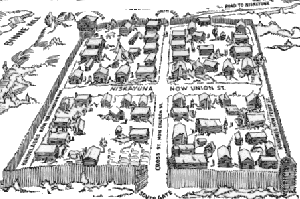Friday, February 28, 2014
White feather, black feather
I am fond of feathers; this is a scan of a small one I found many years ago.
Still sorting through the print matter here. Today I picked up a 24 page historical pamphlet called The Story of the Schenectady Massacre, from the stack on my bedside table. Copyright 1940, reprinted 1977. I don't remember where I got it; I think it must have belonged to my mother. The Burning of Schenectady took place on the night of February 8, 1690; this booklet was prepared for the 250th anniversary. Now the 300th anniversary has come and gone. The event took place during the very beginning of The French and Indian Wars, being part of the first one, King William's War, which ran from 1688-1697. The 60 dead this night included 38 men, 10 women and 12 children. The raiders departed with 27 prisoners and 50 horses. There is an illustrated account of the raid on this blog. This was the beginning of the call for union of the British colonies against the French and Indian domination of this area, which over the next two hundred years eventually resulted in the formation of the USA.
I had the good fortune to be born in Schenectady and to grow up there because my father worked for the General Electric Company. My public schooling included a good deal of New York State history, the Five Fires of the Iroquois Confederation, the Erie Canal, Henry Hudson, Dewitt Clinton, Thomas A. Edison and all sorts of other interesting stuff. And I have kept up this interest over the years by reading various accounts, such as the life of the Iroquois leader known as Joseph Brant. Because of the facts, the lists, and the reproduced town plan, this little booklet has captured my heart; I don't know who wrote it--it might have been a work-for-hire sponsored by the Historical Society and the Chamber of Commerce. The work includes a two-page list of the people killed with details, and one page of the people captured and taken to Canada. Some of these died or were killed on the wintertime trip and a few were later ransomed.
I particularly like this:
List of the Goods sent from New York to be distributed among the Refugees of Schoonechtede, to wit:
This is a two-page list of every single thing sent, down to 7 pairs of socks, with the name of every person and what they got. It makes me giggle that they distributed 2349 ells (cut into varying lengths) to 38 different people of a kind of Osnaberg linen, when they only were sent 2348 1/2 ells. The simplicity of the relief (mostly fabric) really gives one an insight on the material culture of the time.
The local Mohawks (who had found the Dutch settlers a useful source of firearms and other goodies) asked the few remaining people to not to abandon, but to continue the settlement. (The massacre was done by French soldiers and Indians come down from Canada on a long winter march with the original intention to attack the settlement at Albany.)
Below is a plan of Schenectady before the massacre and burning.
Tonight's text is the record of what the Mohawks said at a meeting with the survivors:
"BRETHERN:--Wee are sory and Extreamly grieved for ye murther lately Committed by ye French upon our brethren of Shinnectady wee Esteem this evill at Shinnectady, we cannot accompt it a great victory for itt is done byyway of Deciet.
"Brethern:--Doe not be discouraged this is butt a beginning of ye Warr. We are strong enough, the whole house have there Eyes upon yrs and they only stay your motion and will bee ready to doe wathever shall be resolved upon by our Brethren.
We Recommen ye brethren to keep good watch and if any Enemies come take care yt messengers be more speddily sent to us than lately was done we would not advise ye brethern quite to desert Shinnectady but to make a fort there. The Enemy would be too glorious to see it quite desolate and yr town is not well fortyfied ye stockades are so short ye Indians can jump over them like a dogg."
If there is not a poem, or an epic, in this, where is one?? When the settlement was rebuilt it was as a fort with the stockade made Indian-fashion of small tree trunks interlaced with branches. And they kept a watch and locked the gates at night.
Subscribe to:
Post Comments (Atom)


No comments:
Post a Comment